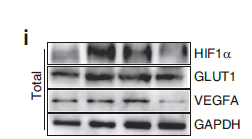
主要信息
Target
SPTA1
Host Species
Rabbit
Reactivity
Human, Mouse
Applications
WB
MW
266kD (Calculated)
Conjugate/Modification
Unmodified
货号: YN4314
规格
价格
货期
数量
200μL
¥3,780.00
现货
0
100μL
¥2,300.00
现货
0
40μL
¥960.00
现货
0
加入购物车


已收藏


收藏
详细信息
推荐稀释比
WB 1:500-2000
组成
Liquid in PBS containing 50% glycerol, 0.5% BSA and 0.02% sodium azide.
特异性
This antibody detects endogenous levels of SPTA1 at Human/Mouse
纯化工艺
The antibody was affinity-purified from rabbit antiserum by affinity-chromatography using epitope-specific immunogen.
储存
-15°C to -25°C/1 year(Do not lower than -25°C)
浓度
1 mg/ml
理论分子量
266kD
修饰
Unmodified
克隆性
Polyclonal
同种型
IgG
相关产品
抗原&靶点信息
免疫原:
Synthesized peptide derived from human SPTA1 AA range: 1217-1267
展开内容
特异性:
This antibody detects endogenous levels of SPTA1 at Human/Mouse
展开内容
基因名称:
SPTA1 SPTA
展开内容
蛋白名称:
SPTA1
展开内容
背景:
Spectrin is an actin crosslinking and molecular scaffold protein that links the plasma membrane to the actin cytoskeleton, and functions in the determination of cell shape, arrangement of transmembrane proteins, and organization of organelles. It is a tetramer made up of alpha-beta dimers linked in a head-to-head arrangement. This gene is one member of a family of alpha-spectrin genes. The encoded protein is primarily composed of 22 spectrin repeats which are involved in dimer formation. It forms weaker tetramer interactions than non-erythrocytic alpha spectrin, which may increase the plasma membrane elasticity and deformability of red blood cells. Mutations in this gene result in a variety of hereditary red blood cell disorders, including elliptocytosis type 2, pyropoikilocytosis, and spherocytic hemolytic anemia. [provided by RefSeq, Jul 2008],
展开内容
功能:
Disease:Defects in SPTA1 are a cause of hereditary pyropoikilocytosis (HPP) [MIM:266140]. HPP is an autosomal recessive disorder characterized by hemolytic anemia, microspherocytosis, poikilocytosis, and an unusual thermal sensitivity of red cells.,Disease:Defects in SPTA1 are the cause of elliptocytosis type 2 (EL2) [MIM:182860]. EL2 is a Rhesus-unlinked form of hereditary elliptocytosis, a genetically heterogeneous, autosomal dominant hematologic disorder. It is characterized by variable hemolytic anemia and elliptical or oval red cell shape.,Disease:Defects in SPTA1 are the cause of spherocytosis type III (SPH3) [MIM:270970]. SPH3 is a disorder characterized by severe hemolytic anemia. Inheritance is autosomal recessive.,Function:Spectrin is the major constituent of the cytoskeletal network underlying the erythrocyte plasma membrane. It associates with band 4.1 and actin to form the cytoskeletal superstructure of the erythrocyte plasma membrane.,miscellaneous:This complex is anchored to the cytoplasmic face of the plasma membrane via another protein, ankyrin, which binds to beta-spectrin and mediates the binding of the whole complex to a transmembrane protein band 3. The interaction of erythrocyte spectrin with other proteins through specific binding domains lead to the formation of an extensive subplasmalemmal meshwork which is thought to be responsible for the maintenance of the biconcave shape of human erythrocytes, for the regulation of plasma membrane components and for the maintenance of the lipid asymmetry of the plasma membrane.,similarity:Belongs to the spectrin family.,similarity:Contains 1 SH3 domain.,similarity:Contains 22 spectrin repeats.,similarity:Contains 3 EF-hand domains.,subunit:Composed of nonhomologous chains, alpha and beta, which aggregate side-to-side in an antiparallel fashion to form dimers, tetramers, and higher polymers.,
展开内容
细胞定位:
Cytoplasm, cytoskeleton. Cytoplasm, cell cortex.
展开内容
研究领域:
>>Apoptosis
展开内容
文献引用({{totalcount}})
货号: YN4314
规格
价格
货期
数量
200μL
¥3,780.00
现货
0
100μL
¥2,300.00
现货
0
40μL
¥960.00
现货
0
加入购物车


已收藏


收藏
Recently Viewed Products
Clear allToggle night Mode
{{pinfoXq.title || ''}}
Catalog: {{pinfoXq.catalog || ''}}
Filter:
All
{{item.name}}
{{pinfo.title}}
-{{pinfo.catalog}}
主要信息
Target
{{pinfo.target}}
Reactivity
{{pinfo.react}}
Applications
{{pinfo.applicat}}
Conjugate/Modification
{{pinfo.coupling}}/{{pinfo.modific}}
MW (kDa)
{{pinfo.mwcalc}}
Host Species
{{pinfo.hostspec}}
Isotype
{{pinfo.isotype}}
产品 {{index}}/{{pcount}}
上一个产品
下一个产品
{{pvTitle}}
滚轮缩放图片
{{pvDescr}}




















